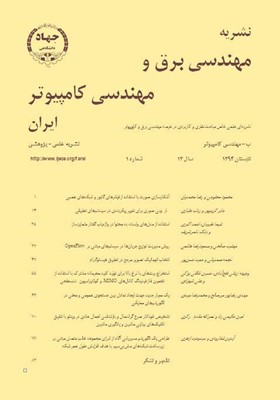انتخاب اتوماتیک تصویر مرجع در تطبیق هیستوگرام
محورهای موضوعی : مهندسی برق و کامپیوترنجمه صمدیانی 1 * , حمید حسنپور 2
1 - دانشگاه شاهرود
2 - دانشگاه صنعتی شاهرود
کلید واژه: بهبود کنتراست تطبيق هيستوگرام برابرسازي هيستوگرام معيار شباهت,
چکیده مقاله :
در اين مقاله روشي براي انتخاب اتوماتيک تصوير مرجع در تطبيق هيستوگرام ارائه شده است. تطبيق هيستوگرام يکي از سادهترين روشهاي مکاني بهبود تصوير است که با توجه به هيستوگرام تصوير مرجع، کنتراست تصوير اوليه را بهبود ميدهد. در روشهاي معمول تطبيق هيستوگرام، کاربر براي يافتن مناسبترين تصوير مرجعي که بهتر از ساير تصاوير هدف، کنتراست تصوير را بهبود ببخشد، نيازمند انجام چندين آزمايش با عکسهاي گوناگون روي تصوير اوليه است اما اين مقاله، روشي براي انتخاب اتوماتيک تصوير مرجع در تطبيق هيستوگرام ارائه ميدهد. روش کار بدين صورت است که براي تجزیه مؤلفه روشنایی از رنگ، ابتدا تصاوير از فضاي رنگي RGB به فضاي HSV انتقال مييابند. سپس تصوير مرجع مناسب براي بهبود تصوير اوليه، توسط يک معيار شباهت با سنجش ميزان شباهت بين هيستوگرام مؤلفه روشنایی تصاوير موجود در پايگاه داده و هيستوگرام مؤلفه روشنایی تصوير اوليه انتخاب ميشود. به عبارت ديگر، تصويري که هيستوگرام آن شباهت بيشتري به هيستوگرام تصوير اوليه دارد در بهبود کنتراست تصوير اوليه، موفقتر عمل ميکند. انجام اين کار علاوه بر به دست آوردن نتيجه مطلوب، کاربر را از دغدغه انتخاب يک تصوير مرجع مناسب براي بهبود تصوير اوليه نيز بينياز ميکند. همچنين روش ارائهشده قابل استفاده روي تصاوير هر دو حوزه RGB و خاکستري نيز ميباشد.
In this paper, a method is proposed to automatically select reference image in histogram matching. Histogram matching is one of the simplest spatial image enhancement methods which improves contrast of the initial image based on histogram of the reference image. In the conventional histogram matching methods, user should perform several experiments on various images to find a suitable reference image. This paper presents a new method to automatically select the reference image. In this method, images are converted from RGB to HSV, and the illumination (V) components are considered to select the reference image. The appropriate reference image is selected using a similarity measure via measuring the similarity between the histograms of the initial image and histograms of the images in the data base. Indeed, an image with similar histogram to the histogram of the original images is more appropriate to choose as the reference image for histogram matching. Results in this research indicate superiority of the proposed approach, compared to other existing approaches, in image enhancement via histogram matching. In addition, the user would have no concern in selecting an appropriate reference image for histogram matching in the proposed approach. This approach is applicable to both RGB and gray scale images.
[1] O. P. Verma, P. Kumar, M. Hanmandlu, and S. Chhabra, "High dynamic range optimal fuzzy color image enhancement using artificial ant colony system," Applied Soft Computing, vol. 12, no. 1, pp. 394-404, Jan. 2012.
[2] S. Hashemi, S. Kiani, N. Noroozi, and M. Ebrahimi Moghaddam, "An image contrast enhancement method based on genetic algorithm," Pattern Recognition Letters, vol. 31, no. 13, pp. 1816-1824, Oct. 2010.
[3] Z. Al-Ameen, G. Sulong, and M. G. Johar, "Enhancing the contrast of CT medical images by employing a novel image size dependent normalization technique," Int J. of Bio - Science and Bio - Technology, vol. 4, no. 3, pp. 63-68, Sep. 2012.
[4] A. Choudhury and G. Medioni, "Color contrast enhancement for visually impaired people," in Proc. IEEE Computer Society Computer Vision and Pattern Recognition Workshops, CVPRW'10, pp. 33-40, 13-18 Jun. 2010.
[5] W. Kao, M. Hsu, and Y. Yang, "Local contrast enhancement and adaptive feature extraction for illumination - invariant face recognition," Pattern Recognition, vol. 43, no. 5, pp. 1736-1747, May 2010.
[6] D. Menotti, L. Najman, J. Facon, and A. Araujo, "Multi - histogram equalization methods for contrast enhancement and brightness preserving," IEEE Trans. on Consumer Electronics, vol. 53, no. 3, pp. 1186-1194, Aug. 2007.
[7] R. Gonzalez and R. E. Woods, Digital Image Processing, Prentice Hall Publication, 2nd edition, pp. 88-103, 2001.
[8] C. Lee, C. Lee, Y. Y. Lee, and C. –S. Kim, "Power - constrained contrast enhancement for emissive displays based on histogram equalization," IEEE Trans. on Image Processing, vol. 21, no. 1, pp. 80-93, Jan. 2012.
[9] H. J. Kwak and G. T. Park, "Image contrast enhancement for intelligent surveillance systems using multi - local histogram transformation," J. of Intelligent Manufacturing, vol. 25, no. 2, pp. 303-318, May 2012.
[10] S. Jye, B. Marissa, and T. Paul, "Histogram matching for the generation of ventilation - perfusion difference images in SPECT lung scanning: a phantom study," The Int. J. of Medical Physics Research and Practice, vol. 39, no. 6, pp. 3026-3030, Jun. 2012.
[11] S. P. Ehsani, H. S. Mousavi, and B. H. Khalaj, "Iterative histogram matching algorithm for chromosome image enhancement based on statistical moments," in Proc. 9th IEEE Int. Symp. Biomedical Imaging, ISBI'12, pp. 214-217, 2-5 May 2012.
[12] P. Pavithra, N. Ramyashree, T. V. Shruthi, and J. Majumdar, "Image enhancement by histogram specification using multiple target images," Int. J.l of Electronics & Communication Technology, vol. 1, no. 2-4, pp. 193-201, Aug. 2010.
[13] S. Debashis and K. Pal Sankar, "Automatic exact histogram specification for contrast enhancement and visual system based quantitative evaluation," IEEE Trans. on Image Processing, vol. 20, no. 5, pp. 1211-1220, May 2011.
[14] Nasa Langley Research Center, Retinex Image Processing, http://dragon.larc.nasa.gov/retinex/pao/news, Retrived in Oct. 2013.
[15] H. Hassanpour, A. Darvishi, and A. Khalili, "A regression - based approach for measuring similarity in discrete signals," Int. J. of Electronics, vol. 98, no. 9, pp. 1141-1156, Sep. 2011.

